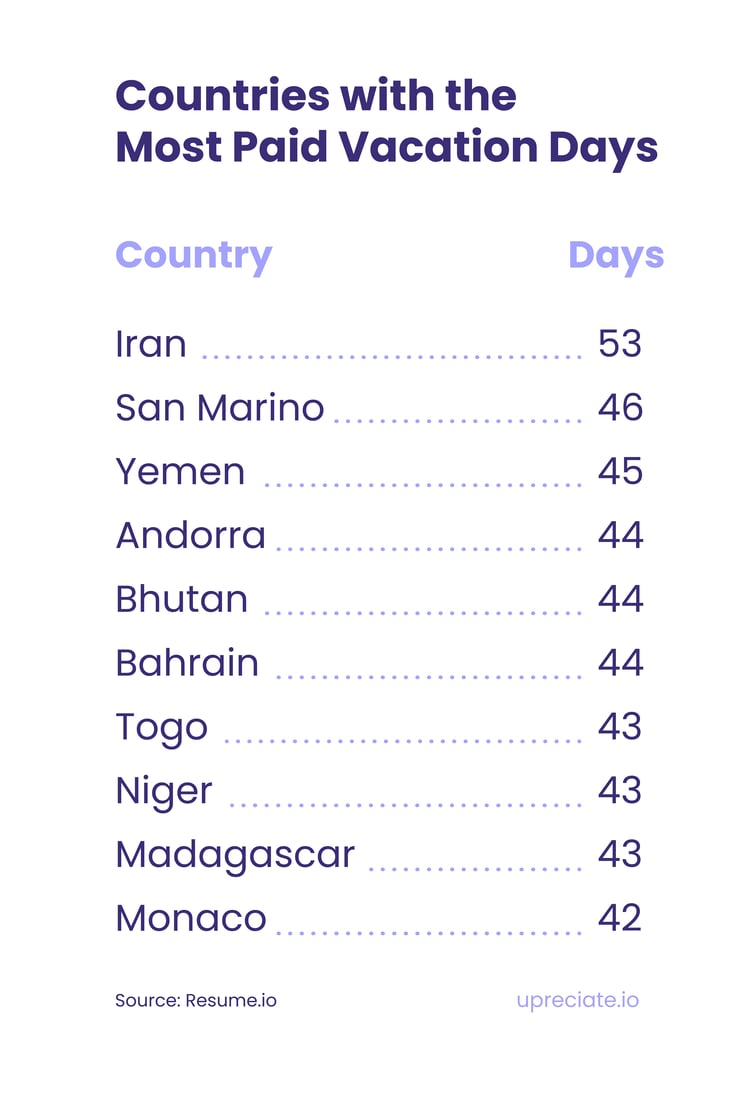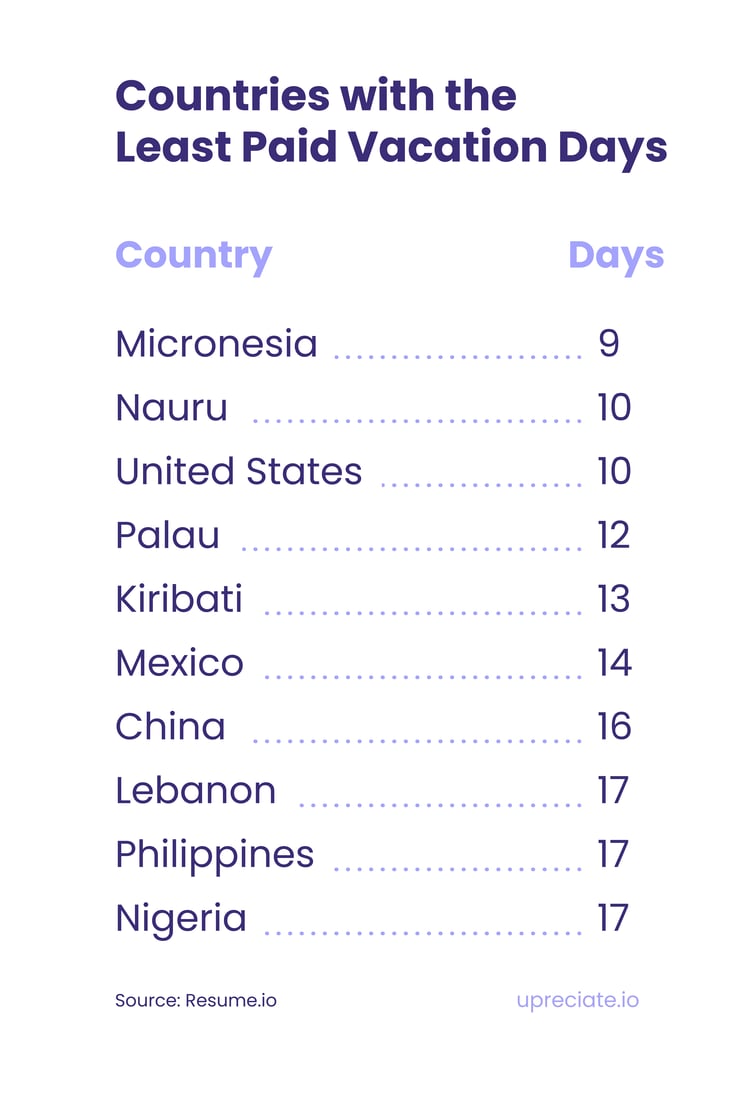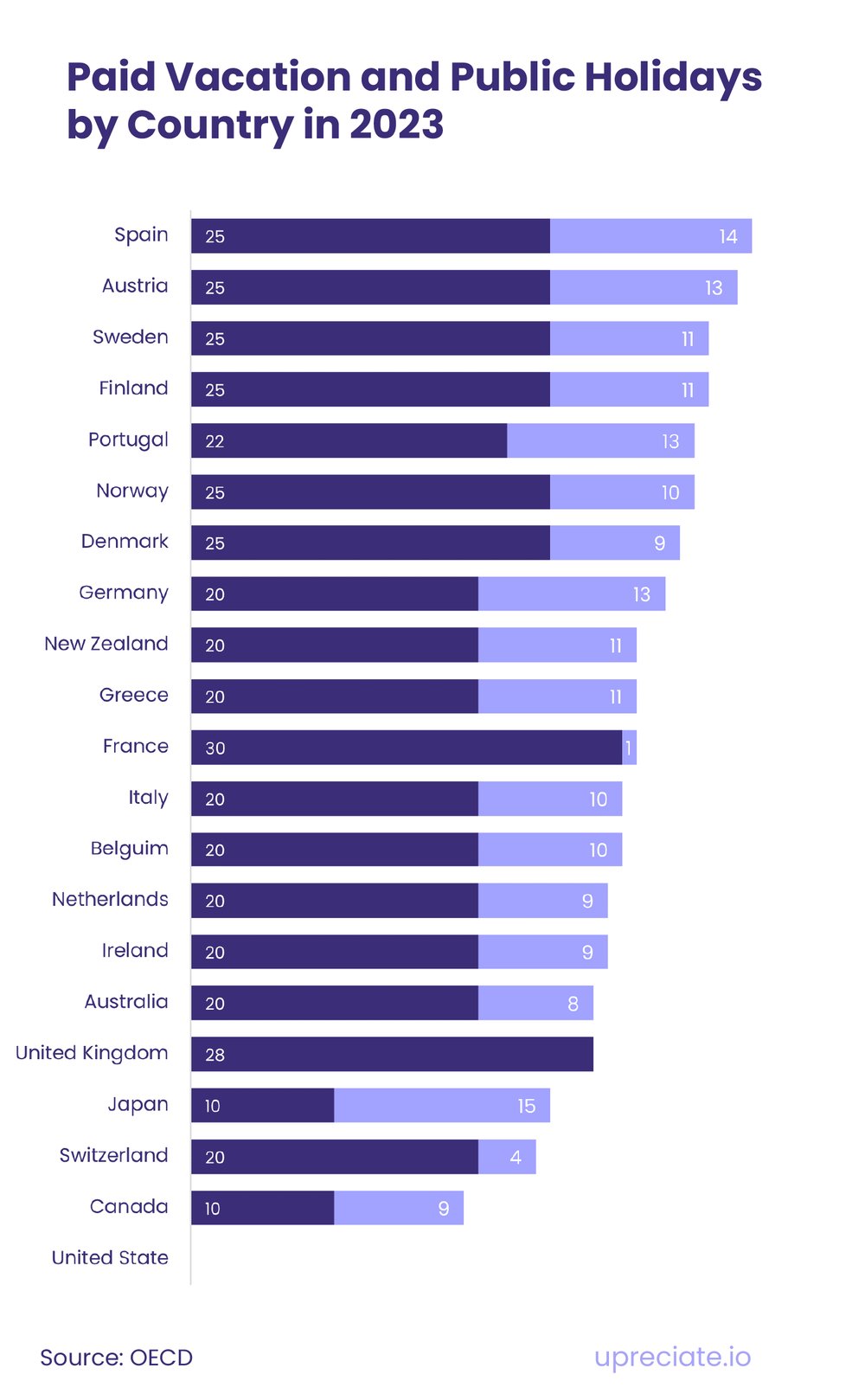Paid vacation policies vary widely across countries. Some countries, like the United States, don't have mandated paid vacation days at the federal level, while European Union countries must by law grant all employees a minimum of 4 weeks of paid vacation. In Iran employees can enjoy as much as 53 days of paid time off (PTO) per year, imagine that!
Even within each country, these policies vary from company to company, as part of their compensation package. It has become a company benefit very much appreciated that can make a difference when attracting and retaining talent. Many companies have generous paid vacation policies in place, so it must be in everyone’s best interest, right? Let’s look at some of them 👀
Companies that Offer the Best Vacation Policies
Several companies are known for their generous and innovative paid vacation policies. Here are a few companies that are setting the example:
- Netflix: Netflix is famous for its "unlimited" vacation policy. Employees can take as much vacation time as they want, as long as their work responsibilities are met and they communicate with their team.
- HubSpot: HubSpot offers a flexible vacation policy called "HubSpot's Vacation for Life." Employees can take as much time off as they need, with the understanding that they're responsible for managing their workload and meeting their goals.
- LinkedIn: LinkedIn offers a "Discretionary Time Off" policy, where employees have the flexibility to take time off when they need it, without a set number of days. The focus is on results and output rather than tracking specific vacation days.
- Buffer: Buffer has an "Open" vacation policy, which means there's no formal limit on vacation days. Employees are encouraged to take time off whenever they feel it's necessary, and there's an emphasis on communication and planning with the team.
- Evernote: Evernote provides employees with a minimum of 25 days of paid time off, plus an additional week off during the company-wide summer and winter breaks.
- Dropbox: Dropbox offers its employees a generous amount of paid vacation time, along with a "$1,000 Vacation Stipend" to encourage them to actually go on vacation and fully disconnect from work.
- FullContact: FullContact has a "Paid, Paid Vacation" policy. In addition to regular paid time off, the company provides employees with $7,500 to go on vacation and truly unplug from work.
Countries With Most and Least Paid Vacation
Let’s find out where employees are entitled to the most time off whilst still being paid.
This totals the number of vacation days required by law and includes paid public holidays plus Paid Vacation Days.
Surely these countries prioritize the well-being of employees by offering generous vacation time and a strong focus on work-life balance. However, it's worth noting that while these regulations provide a baseline, actual vacation entitlements can vary based on individual employment contracts, industries, and collective agreements within each country.


Paid Time Off (PTO) by Country in 2023
(Includes Paid Vacation and Paid Public Holidays)
Spain, Austria, Sweeden, Finland and Portugal are the 5 OECD countries that offer the most PTO, when you add the public holidays to the paid vacation days. On the other end of the spectrum there’s the U.S., the only OECD country with zero days of paid leave and the second lowest number of paid vacation days in the world (10).
According to Forbes, the average American worker gets 11 days of paid vacation per year. In the private sector, the average number of paid vacation days after five years of service increases to 15 days. After 10 years of service, it rises again to 17 days. This is a clear consequence of the regulations in place about holidays and leave entitlements and this is why it is so important for countries to legislate on this matter.

6 Countries with Some of the Least Generous Paid Vacation Policies
Countries with less favourable regulations about holidays and leave entitlements might have shorter mandated vacation periods and fewer public holidays. Some examples include:
- United States: The U.S. does not have federal laws mandating paid vacation or holidays. Paid time off varies by employer, and there are no legal requirements for a minimum number of vacation days.
- China: While Chinese law mandates five days of paid leave after one year of service, this is relatively low compared to some other countries.
- Japan: Japanese employees typically receive around 10-15 days of paid vacation per year, which is often considered lower than in other developed countries.
- Mexico: While Mexican law mandates six paid vacation days per year, this is relatively limited compared to countries with more generous policies.
- South Korea: South Korean employees typically receive around 15 days of paid vacation per year, but cultural and workplace expectations often lead to employees not using their full allocation.
- Singapore: Singaporean employees typically receive around 14 days of paid vacation per year, which can be considered lower than some other developed countries.
These countries may have fewer regulations in place to ensure ample time off for employees, which can impact work-life balance and employee well-being. However, it's important to consider that while these are general trends, variations can exist within each country based on specific employment arrangements and industries.
9 Reasons Why Offer Paid Vacation
So, what is it that makes paid vacation such a win-win for everyone? Paid Time Off (PTO) offers several benefits to both employees and employers, contributing to a healthier and more productive work environment. Here are some reasons why PTO is so important:
- Work-Life Balance: Paid vacations provide employees with the opportunity to recharge, relax, and spend quality time with their families and friends. This balance between work and personal life helps prevent burnout and maintains overall well-being.
- Improved Productivity: Taking regular breaks and vacations can actually improve productivity. When employees return from a vacation, they tend to be more refreshed, motivated, and creative, leading to increased efficiency and better performance at work.
- Reduced Burnout: Continuous work without breaks can lead to burnout, characterized by emotional exhaustion, reduced performance, and a sense of detachment from work. Paid vacations help prevent burnout by allowing employees to detach from work-related stressors temporarily.
- Enhanced Mental Health: Vacations provide an opportunity for employees to relax, unwind, and engage in activities that promote their mental health. Disconnecting from work can reduce anxiety and stress, contributing to better overall mental well-being.
- Higher Job Satisfaction: Employees who receive paid vacation benefits tend to feel more valued by their employers. This can lead to higher job satisfaction and increased loyalty, resulting in reduced turnover rates.
- Attraction and Retention of Talent (in case you offer more than required by law): Competitive benefits packages, including paid vacation, can attract top talent to a company and encourage current employees to stay. Organizations that offer paid vacation are often seen as more attractive places to work.
- Boosted Creativity and Innovation: Taking time off allows employees to explore new experiences, cultures, and activities. This exposure can spark creativity and innovation, as individuals bring back fresh perspectives and ideas to their work.
- Health Benefits: Chronic stress and overwork can negatively impact physical health. Paid vacations help employees reduce stress, which in turn can lead to improved cardiovascular health, reduced risk of chronic diseases, and better overall physical well-being.
- Positive Workplace Culture: Organizations that prioritize employee well-being and offer paid vacation demonstrate a commitment to creating a positive workplace culture. This culture, in turn, fosters a sense of belonging, cooperation, and collaboration among employees.
Paid Time Off policies are crucial for attracting and retaining talent
High turnover rates can be costly for businesses due to recruitment, training, and productivity loss. Offering generous PTO can contribute to higher employee retention rates, as employees are more likely to stay with a company that values their well-being and provides ample time off.
In today's competitive job market, employees value work-life balance, flexibility, and overall well-being. Companies that offer generous and well-structured PTO policies can stand out and create a more appealing work environment for potential candidates. Paid Time Off policies are a critical component of a comprehensive employee benefits package. They go beyond financial compensation and play a pivotal role in attracting and retaining top talent. By promoting work-life balance, flexibility, and employee well-being, companies can create a positive work environment that appeals to candidates and fosters long-term employee loyalty.

